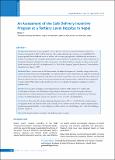Please use this identifier to cite or link to this item:
https://hdl.handle.net/20.500.14356/1922| Title: | An Assessment of the Safe Delivery Incentive Program at a Tertiary Level Hospital in Nepal |
| Authors: | Baral, G |
| Citation: | BaralG. (2012). An Assessment of the Safe Delivery Incentive Program at a Tertiary Level Hospital in Nepal. Journal of Nepal Health Research Council. https://doi.org/10.33314/jnhrc.v0i0.305 |
| Issue Date: | 2012 |
| Publisher: | Nepal Health Research Council |
| Article Type: | Original Article |
| Keywords: | Impact Incentive Maternity Safe-delivery System research |
| Series/Report no.: | May-Aug, 2012;305 |
| Abstract: | Abstract Background: Maternity incentive program of Nepal known as Safe Delivery Incentive Program (SDIP) was introduced nationwide in 2005 with the intention of increasing utilization of professional care at childbirth. The program provided both childbirth service as well as ‘cash’ to women giving birth in a health facility in addition to incentives to health provider for each delivery attended, either at home or the facility. Due to a lack of uniformity in its implementation and administrative delays, the program was reformed and even extended to many not-for-profit health institutions in early 2007, and implemented as a ‘Safer Mother Program’ popularly known as “Aama-Suraksha-Karyakram†since January 2009. Methods: This is a system research with observational and analytical components. Plausibility design is selected to evaluate the performance-based funding (PBF) as a system level intervention of maternity care using two instruments: Pay-For-Performance and Conditional-Cash-Transfer. It uses interrupted time-series to control for the natural trend. Research tools used are interviews, the focus group discussions and literature review. Numerical data are presented in simple graphs. While online random number generator was used partly, the purposive sampling was used for qualitative data. Results: There is a gross discrepancy in non-targeted service delivery at the tertiary level health facility. Overflooding of maternity cases has hampered gynecological admission and surgical management delaying subspecialty care and junior physicians’ training. With the same number and quality of physical facility and human resource, the additional program has put more strains to service providers and administrators. Conclusions: There should be adequate planning and preparation at all levels of health facilities; implementing a new program should not adversely affect another existing service delivery system. For the optional implementation, hospital organogram should be revised; and physical facilities and the low-risk birthing-centers with referral linkages should be expanded. Keywords: impact; incentive; maternity; safe-delivery; system research |
| Description: | Original Article |
| URI: | http://103.69.126.140:8080/handle/20.500.14356/1922 |
| ISSN: | Print ISSN: 1727-5482; Online ISSN: 1999-6217 |
| Appears in Collections: | Vol 10 No 2 Issue 21 May - Aug, 2012 |
Files in This Item:
| File | Description | Size | Format | |
|---|---|---|---|---|
| 305-Article Text-304-1-10-20130823.pdf | Fulltext Download | 1.01 MB | Adobe PDF |  View/Open |
Items in DSpace are protected by copyright, with all rights reserved, unless otherwise indicated.
